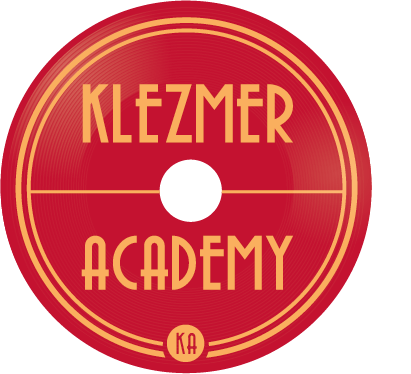This series begins with what I consider one of the most interesting tunes in the klezmer repertoire. The earliest recording of it that I have heard is “Taniec Rabina” (Rabbi’s Dance) by the Belf Orchestra, recorded in Roumenia in 1912.
In this iteration it is a simple, two section tune in which the second section is essentially the first section raised up a third:
The Belf performance is of particular note because they take this very simple tune and play it entirely over the root chord – in the version notated here, that would be D major. There is no cadence chord, which is extremely unusual. Instead, the piano player employs a huge vocabulary of rhythmic variation to keep things interesting. The net effect is to conjure up the hypnotic, almost mystical image of a Chassidic rebbe dancing.
In 1920. Lt. Joseph Frankel recorded an intriguing version of this tune on Emerson under the title, "Der Chosid Tantzt part 1." Unlike the main body of his commercial recordings, which feature a large band, both sides of this disc feature Frankel himself on clarinet and an unknown accordion player. In Frankel's version, the A and B sections are virtually identical to those of "Taniec Rabina," with a few small rhythmic variations. The accordionist does change chords, but his choices appear to be a bit random, as was often the case during these early years of recording. Then there is an added C section:
Alert readers will perhaps recognize this melody. The first four bars are virtually identical to the first four bars of the C section of another Belf tune, "Nakhes fun Kinder,"
while the last four bars are absolutely identical to the end of the C section of a tune Frankel had recorded with his band the previous year, "Dem Rebin's Nigun, Oj Tate."
While it might seem that this is a random mish-mosh that proves the claim that all klezmer tunes sound alike, the connections among these melodic segments are actually strong. The rhythmic change in the first four bars alters the Belf melody to reflect the thematic rhythm pattern of the A and B sections, the recurring four sixteenths followed by an eight note. The part of the melody borrowed from "Oj Tate" shares that same recurring pattern. The net result is a cohesive, organic tune.
In 1921, Harry Kandel recorded another version of this melody for the Victor label under the title “Flaskadriga”. In this rendition the A and B sections are identical to the previous two versions, and like the Frankel, there is an added C section:
After the shout chorus, which is deceptive in that unlike the usual shout chorus, it neither establishes a new tonal center for the time (Gm would be what you might expect, based on the first four bars of the section) nor modulates into a new mode (F major, as indicated by the second four bars). Instead, the shout chorus is just an interesting interlude that snaps immediately back to the starting tonality, while the melody itself echoes the very distinctive rhythmic figures of the first two sections of the tune.
The last iteration of this tune, "Dem Reben's Tanz," was recorded by Art Shryer in 1929. This recording is particularly interesting because of the spoken introduction, which sets the stage for the joyous spectacle of the Rebbe dancing. In addition, every time it comes around, the A section includes a large chorus of voices singing the tune in the style of a Chassidic nign, which references the title in a much more literal way than the hypnotic playing of the Belf orchestra.
The first half of the A section is identical to that of the previous three versions, but then, although it maintains the same rhythmic figure, the tune goes off in a completely different direction:
The next section of the tune, while evolving organically from the A section, bears much less resemblance to the original. The only hint is a rhythmic echo in the sixth measure:
The C section returns to the rhythmic figures of the A section (and of the original tune) but resolves into very new territory:
The final section of “Dem Rebens Tanz” slows the rhythm to eighth notes but builds dramatically to a fitting resolution:









